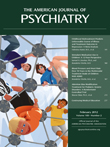Conceptual Issues in Psychiatric Gene-Environment Interaction Research
To the Editor: In their critical review of candidate gene-by-environment (cG×E) interaction research, published in the October 2011 issue of the Journal, Duncan and Keller (1) raise several methodological issues that cast serious doubt on many published G×E findings. While informative in many respects, their virtually exclusive methodological perspective does not address an important conceptual issue that has emerged in recent years concerning cG×E interaction: putative risk alleles often operate as plasticity alleles (2). Duncan and Keller appear to maintain the tradition of viewing all G×E inquiry from a diathesis-stress perspective, which stipulates that individuals carrying risk alleles will be more likely to develop psychopathology in the face of adversity relative to individuals without risk alleles under the same conditions. However, as it turns out, ever more cG×E findings appear consistent with an alternative—and more evolutionarily plausible—conceptual framework: differential susceptibility. According to this theory, some individuals are, for genetic reasons, more responsive to both negative and positive environmental influences (3).
This theory raises the possibility that one reason cG×E findings often do not replicate is the misconceptualization of candidate genes as risk genes. If individuals carrying certain plasticity alleles are disproportionately susceptible to a wide range of developmental experiences and contextual exposures, not just adverse ones, then the failure to include propitious factors in cG×E research could increase false negative findings. Consider in this regard Kilpatrick and colleagues' study (4) of the role of the serotonin-transporter-linked polymorphic region (5-HTTLPR) in moderating the effect of hurricane exposure on posttraumatic stress disorder (PTSD). Had the investigators not been in a position to detect the disproportionate benefit that those hurricane-exposed individuals with short—putative “risk”—alleles accrued from high social support, then it seems likely that their G×E study would also have yielded null results. And this is because, as it turned out, it was only those especially susceptible to positive and negative environmental influences (i.e., short allele carriers) but exposed only to the latter—hurricane and low social support—who proved especially likely to develop PTSD.
Given that samples will usually vary in both environmental risk exposure and availability of protective resources and that candidate genes may be associated with elevated susceptibility to both, the failure to explicitly measure and include positive supportive aspects of the environment in cG×E studies may be one important reason why G×E findings fail to replicate. These practices, we contend, derive from the embracing of vulnerability-only rather than plasticity models.
1. : A critical review of the first 10 years of candidate gene-by-environment interaction research in psychiatry. Am J Psychiatry 2011; 168:1041–1049Link, Google Scholar
2. : Vulnerability genes or plasticity genes? Mol Psychiatry 2009; 14:746–754Crossref, Medline, Google Scholar
3. : Beyond diathesis-stress: differential susceptibility to environmental influences. Psychol Bull 2009; 135:885–908Crossref, Medline, Google Scholar
4. : The serotonin transporter genotype and social support and moderation of posttraumatic stress disorder and depression in hurricane-exposed adults. Am J Psychiatry 2007; 164:1693–1699Link, Google Scholar



